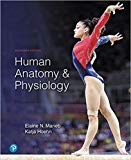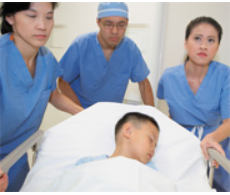
Concept explainers
10-Year-Old Boy with Spinal Injury
On arrival at Holyoke Hospital, Jimmy Chin, a 10–year-old boy, is immobilized on a rigid stretcher so that he is unable to move his head or trunk. The paramedics report that he was awake and alert after his accident at the skateboard park, but crying and complaining that he couldn't get up and that he had a “wicked headache." He has severe bruises on his upper back and head, and lacerations of his back and scalp. His blood pressure is low, body temperature is below normal, lower limbs are paralyzed, and he is insensitive to painful stimuli below the nipples. Although still alert on arrival, Jimmy soon begins to drift in and out of unconsciousness.

Jimmy is immediately scheduled for a CT scan, and an operating room is reserved.
Relative to Jimmy's condition:
Two days after his surgery, Jimmy is alert and his MRI scan shows no residual brain injury, but does show pronounced swelling and damage to the spinal cord at T4. On physical examination, Jimmy shows no reflex activity below the level of the spinal cord injury. His blood pressure is still low.
8. How does Jimmy’s excessively high blood pressure put him at risk?
Want to see the full answer?
Check out a sample textbook solution
Chapter 14 Solutions
Human Anatomy & Physiology Plus Modified Mastering A&P with Pearson eText -- Access Card Package 11th edition
- 1. Match each vocabulary term to its best descriptor A. affinity B. efficacy C. inert D. mimic E. how drugs move through body F. how drugs bind Kd Bmax Agonist Antagonist Pharmacokinetics Pharmacodynamicsarrow_forward50 mg dose of a drug is given orally to a patient. The bioavailability of the drug is 0.2. What is the volume of distribution of the drug if the plasma concentration is 1 mg/L? Be sure to provide units.arrow_forwardDetermine Kd and Bmax from the following Scatchard plot. Make sure to include units.arrow_forward
- Choose a catecholamine neurotransmitter and describe/draw the components of the synapse important for its signaling including synthesis, packaging into vesicles, receptors, transporters/degradative enzymes. Describe 2 drugs that can act on this system.arrow_forwardThe following figure is from Caterina et al. The capsaicin receptor: a heat activated ion channel in the pain pathway. Nature, 1997. Black boxes indicate capsaicin, white circles indicate resinferatoxin. a) Which has a higher potency? b) Which is has a higher efficacy? c) What is the approximate Kd of capsaicin in uM? (you can round to the nearest power of 10)arrow_forwardWhat is the rate-limiting-step for serotonin synthesis?arrow_forward
- Surgical Tech For Surgical Tech Pos CareHealth & NutritionISBN:9781337648868Author:AssociationPublisher:Cengage
 Anatomy & PhysiologyBiologyISBN:9781938168130Author:Kelly A. Young, James A. Wise, Peter DeSaix, Dean H. Kruse, Brandon Poe, Eddie Johnson, Jody E. Johnson, Oksana Korol, J. Gordon Betts, Mark WomblePublisher:OpenStax College
Anatomy & PhysiologyBiologyISBN:9781938168130Author:Kelly A. Young, James A. Wise, Peter DeSaix, Dean H. Kruse, Brandon Poe, Eddie Johnson, Jody E. Johnson, Oksana Korol, J. Gordon Betts, Mark WomblePublisher:OpenStax College - Understanding Health Insurance: A Guide to Billin...Health & NutritionISBN:9781337679480Author:GREENPublisher:Cengage
 Human Biology (MindTap Course List)BiologyISBN:9781305112100Author:Cecie Starr, Beverly McMillanPublisher:Cengage Learning
Human Biology (MindTap Course List)BiologyISBN:9781305112100Author:Cecie Starr, Beverly McMillanPublisher:Cengage Learning





